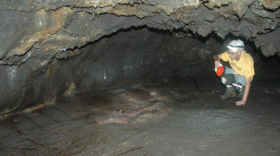U.S. scientists declared Tuesday that two active Big Island volcanoes — one where lava destroyed hundreds of homes in 2018 and another where lava recently stalled before reaching a crucial Big Island highway — have stopped erupting.
“Kīlauea is no longer erupting,” the U.S. Geological Survey's Hawaiian Volcano Observatory said in a statement Tuesday, followed within minutes by a separate one saying, “Maunaloa is no longer erupting.”
Alert levels for both volcanoes were reduced from watch to advisory.
Maunaloa began spewing molten rock on Nov. 27 after being quiet for 38 years, drawing onlookers to take in the incandescent spectacle, and setting some nerves on edge early on among people who’ve lived through destructive eruptions.
It was Maunaloa's longest period of repose, said Ken Hon, the observatory's scientist in charge.
Lava-viewers in Hawaiʻi Volcanoes National Park enjoyed the added rare marvel of being able to see Maunaloa's smaller neighbor, Kīlauea, erupting at the same time.
Kīlauea had been erupting since September 2021. A 2018 Kīlauea eruption destroyed more than 700 residences.
Maunaloa lava didn't pose a threat to any communities, but got within 1.7 miles (2.7 kilometers) of a major highway that connects the east and west sides of the island.
Hon called the two-week spectacle, which is a typical timespan for Maunaloa, “my favorite eruption.”
“It was a beautiful eruption, and lots of people got to see it, and it didn’t take out any major infrastructure and most importantly, it didn’t affect anybody’s life,” he said at a briefing Tuesday.

Hawaiʻi County Civil Defense Director Talmadge Magno said a one-way route that opened to manage traffic from throngs of people watching the lava would close Thursday.
Magno and other county officials had warned that slow-moving lava could force the closure of Saddle Road, also known as Route 200 or Daniel K. Inouye Highway. That prompted motorists to brace for upheaval from a closure that could add hours to commute times on alternate coastal routes.
“Whatever it is — luck, chance — this is probably the best situation that we could ask for from Maunaloa,” Magno said.
For Native Hawaiians, volcanic eruptions have deep cultural and spiritual significance. During Maunaloa's eruption, many Hawaiians took part in cultural traditions, such as singing, chanting and dancing to honor Pele, the deity of volcanoes and fire, and leaving offerings known as “hoʻokupu.”
Lava supply to a Maunaloa fissure ceased on Saturday, the observatory said, and volcanic tremor and earthquakes associated with the eruption “greatly diminished.”
“Spots of incandescence may remain near the vent, along channels, and at the flow front for days or weeks as the lava flows cool,” the observatory's activity summary said. “However, eruptive activity is not expected to return based on past eruptive behavior.”
Lava supply to Kīlauea's Halemaʻumaʻu lava lake ceased on Friday, the observatory said: “Potential remains for resumption of this eruption or initiation of a new eruption at or near the summit of Kīlauea.”
The observatory will continue monitoring the volcanoes for signs of renewed activity.
Yes, you saw it right -- alert levels for BOTH Mauna Loa and Kīlauea were lowered this morning. Neither volcano is erupting right now, and gas emissions are at near-background levels, although HVO volcanologists remain vigilant for changes that might indicate renewed activity. pic.twitter.com/3m4SfZY3nw
— USGS Volcanoes🌋 (@USGSVolcanoes) December 13, 2022
Despite the definitive statements, Hon said there's generally a three-month “cooling off” period before scientists consider the eruption over.
But there's been no history of a Maunaloa rift eruption pausing and restarting, he said, “So we feel pretty confident that this eruption has, in fact, paused and is probably over.”
It was unclear what connection there could be to the volcanoes stopping their eruptions around the same time. The volcanoes can both be seen at the same time from multiple spots in Hawaiʻi Volcanoes National Park near Kīlauea’s caldera.
“So, Kīlauea may have been diminishing already and the Maunaloa eruption may have caused enough physical changes to stop it, or it may have just been headed to stop on its own,” Hon said. “So we don’t have a really good answer for that right now.”
Scientists will look at data to study the relationship between the two volcanoes, he said.






